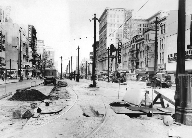
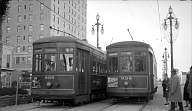
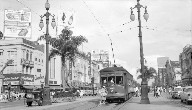
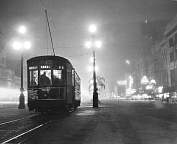
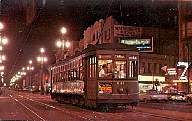
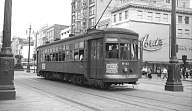
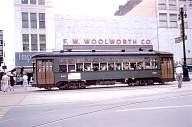
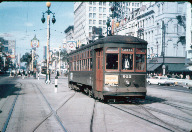
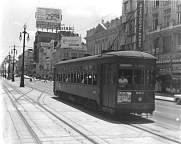
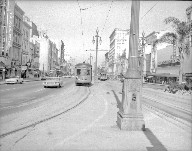
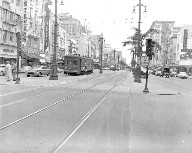
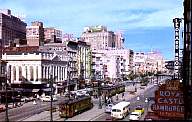

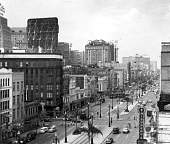
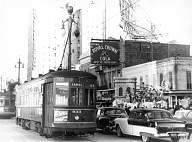

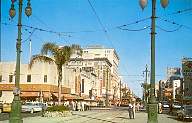
Then in 1957, the city decided to widen the automobile lanes of Canal Street at the expense of the neutral ground. This required moving the ornamental street light poles to a position between the inner and outer tracks, and eliminating the passenger loading area for the St. Charles cars on the outer track at St. Charles Street. At the same time, all the unused outer tracks on Canal between Liberty and Peters were removed. Without interruption to the service on either car line, both of which still had very close headways, some of the rail from the old outer tracks was then used to replace worn rail on the inner tracks. Also, a new crossover was installed between the riverbound inner and outer tracks between Carondelet and St. Charles; otherwise, the removal of the rest of the outer tracks would have isolated the two lines from each other. Finally, all the terrazzo on the neutral ground, now old, dirty, and patched, was chipped out, and a new concrete surface installed. The track work was completed January 31, 1958. The four track terminus and loop at the Liberty Monument was unchanged by the project; even the old, patched terrazzo surface remained.
Click here to view a map of Canal Street trackage in 1958.
| Picture 339. | |
 |
By October 20, 1957, the rebuilding has progressed to the point that the old outer tracks have been removed, except for the one block for the St. Charles cars, seen here. The streetlights have been moved from being next to the curb to the position seen here, next to the inner tracks. The curve in the foreground is the one for St. Charles cars to turn into St. Charles Street. A sharp eye can make out the new crossover between the inner and outer tracks about a half block away. It appears that construction of the new, wider inside traffic lane has begun. |
| Picture 339.2. | |
 |
The date is February 16, 1958, and while track construction has been completed, other work on Canal Street is still in progress. Note the construction fence to our left from car 955; probably the new cobblestone flower pot was still being worked on. The two cars are facing the same direction, implying that they are being turned back at that point. Probably a Mardi Gras parade has blocked the Canal line. Decorations can be seen on the nearest light pole on the right, and the lamps on the next pole beyond it have been given colored globes, undoubtedly for Carnival season. |
| Picture 339.4. | |
 |
Here we see car 945 inbound on the Canal line at Dauphine in the spring or summer of 1958. There is a Katz & Besthoff drugstore on our left, on the downtown side of Canal. Note the cobblestone pots with healthy new palm trees in them. Unfortunately, in the winter of 1962, a bad frost killed all the palm trees in the cobblestone pots. At the left, next to the light pole, is a machine or tool box used in the rebuild, perhaps awaiting use in some last minute touch-up, prior to its removal. |
| Picture 339.6. | |
 |
Times Picayune photographer Erby Aucoin Jr. has Canal car 906 in his viewfinder late one evening, probably between 1958 and 1961. The picture is a timed one, resulting in automobile headlights at the left, and taillights at the right, being blurred to streaks. There is a puff of smoke at the right from the exhaust of an automobile that has moved away. This photo was selected as one of the hundred best of the Times Picayune in the 20th century. — Erby Aucoin Jr. (courtesy of Erby Aucoin III) |
| Pictures 340 and 340.5. | |
 |
Two similar views of Canal car 941. In the upper picture, the car waits for the red light inbound at Camp St. one evening in July 1961. We have a clear view of the conductor waiting for the next passenger to board. In the lower picture, inbound at Baronne St. during the day in March 1964, we see a crowd on the car. There are so many people on the platform that we almost can't see the conductor; he's barely visible at the left edge of the end window, facing the open rear door. It's apparently a warm spring day, with almost all the car windows open. (March is spring in Louisiana, even though it's still cold in the northern USA.) The dash of the car has been repainted with the silver stripe omitted. — Howard W. Ameling (upper) |
 |
|
| Picture 341. | |
 |
Perley Thomas car 926 is outbound on Canal at Carondelet in 1960. The track curve in the foreground carries St. Charles cars from Carondelet to Canal at the beginning of their uptown runs. It seems to be a typical warm New Orleans day, with short-sleeve shirts, hats, and open streetcar windows very much in evidence. — Collection of Seashore Trolley Museum, courtesy of Leo Sullivan |
| Pictures 342 and 343. | |
 |
The upper picture of this pair, looking outward, features Canal car 925 traversing the inner track in the block between Carondelet and St. Charles Streets. In the lower picture, looking inward, car 953 on the St. Charles line passes by on the outer riverbound Canal Street track. The conductor looking out the rear window has nothing to do until the car turns up St. Charles Street and proceeds another block, to the next car stop. Both pictures date from some time between 1958 and 1964. In the upper picture, we see colored globes on the street lights and other decorations for Mardi Gras. Note the crossovers, one from the inner to the outer track (and vice versa if the car reverses ends), forming a connection between the St. Charles and Canal lines; and the other, between the two inner tracks, for turnbacks on the Canal line. Both of these were given this form in the 1957 rebuilding. — Roy Wright (lower) |
 |
|
| Pictures 344 and 345. | |
 |
Two St. Charles cars await the traffic light to turn from Canal Street into St. Charles Street to begin their uptown trips. In the upper picture, note the painted curved lines in the street, which motorists are not supposed to cross while waiting for the light. The lines indicate the overhang of the streetcar body as it makes its turn. There is a special colored light in the traffic signal for the streetcar, and the motorman does not want to miss it because some automobile driver has invaded his space! Any offender will hear the streetcar gong to remind him! The upper picture of car 836 was taken in 1960, and the lower one of car 962 was taken in 1961. — Railway Negative Exchange (both) |
 |
|
| Pictures 346, 347, and 347.2. | |
 |
These views were taken after the 1957 rebuilding The first two were taken from about the same spot as Pictures 255 and 256, the third picture from about a block farther riverward. Notice the close headway on the Canal line—cars average about one block apart. A St. Charles car, outside the line of the relocated light poles, waits to turn right and follow a bus up St. Charles Street. Cobblestone flower pots have replaced the rest of the outer tracks. In the middle and bottom pictures, we can see where the automobile lane lines have recently been respaced after the neutral ground was narrowed in the rebuilding. — Grant L. Robertson (upper), Post Card Specialties (middle) |
 |
|
 |
|
| Pictures 347.5 and 347.7. | |
 |
The upper picture features Canal car 933, with 940 leading it, at LaSalle Street. Note the Mardi Gras parade float in the roadway to the right, the Mardi Gras colored globes on some of the street lights, and the 1950s-popular two-tone paint scheme on the automobile just to the right of car 933. In the lower picture, Canal cars 938 (outbound) and 920 (inbound, with another streetcar in front of it) pass a maintenance or construction vehicle (on the neutral ground, at left) along Canal Street near Basin Street/Elk Place. These pictures are dated February 1958, just a few days after completion of the new trackwork, so the vehicle at the left is probably involved in some last minute construction details. The Lowe's Theater sign can be seen in the background. |
 |
|
| Picture 348. | |
 |
Looking toward the river from Rampart Street on a bright summer day around 1960. The two streetcars are 800-900 series cars on the Canal line. Look at the classic 1950s automobile on the left. There is a big “Maison Blanche” sign on top of that building, still the tallest one in view. Signs can be seen for many other businesses, including F. W. Woolworth at the corner of Rampart and Canal, and McCrory's and Kress down the block. In the upper foreground can be seen the feeder wires for the 600 volt power to the trolley wire, coming up the inside of the light poles from underground. To the left is a glimpse of the wires for the St. Claude trolley coach line, and to the right, the feeder powers the Tulane trolley coach wires. — Customcraft Co. |
Another major change to the Canal Street trackage began May 31, 1964, when the Canal line was dieselized. The inner tracks and the four track terminus and loop at the Liberty Monument were removed, and in their place, bus lanes were installed from Claiborne to the Liberty Monument. This marked the first time that any vehicle other than a streetcar had had the right to operate on the neutral ground of Canal Street. The only trackage remaining on Canal Street was the single block of outer track between Carondelet and St. Charles, which doesn’t even have a passenger boarding area.
| Pictures 381 and 382. | |
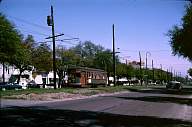 |
Several months before the end of the Canal Street streetcar line, the city began a project to narrow the neutral ground so as to widen the automobile lanes from Claiborne Avenue out to the end of the street at City Park Avenue. These two March 1964 pictures show Canal Street as that project was under way. The upper picture features car 919 near Rendon Street, the lower shows car 935 near Clark Street. |
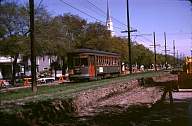 |
|
| Pictures 382.3 and 382.6. | |
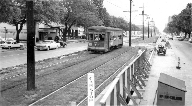 |
These two undated photos also show the construction to
narow the neutral ground on Canal Street to widen the automobile lanes.
That dates the pictures to late 1963 or early 1964. The upper photo
features car 913 somewhere between Galvez and Broad, while the lower photo
shows car 931 approaching the traffic light at Broad Street.
The sign in the lower photo reads:
|
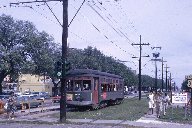 |
|
| Picture 383. | |
 |
The motorman of car 943 is keeping a watchful eye on the photographer as he passes in front of Canal Station heading toward the river. Note the construction in the foreground, part of the narrowing of the neutral ground. This dates the picture to early 1964, just before the close of the Canal line. Warren Easton High School can be glimpsed in the left background. |
| Picture 383.2. | |
 |
The view out Canal Street from the terminal loop on the last full day of streetcar service, Saturday, May 30, 1964. Car 814 and its leader are waiting to pull out on the inner track, while a sister car at the left prepares to navigate the loop. Almost all the cars assigned to Canal line service, including all but three of the surviving 800s, will soon be scrapped. (The last three 800s, and a few 900s, have already been sent off, or soon will be sent off, to museums or other private collections.) At the right, the excavation seen is probably part of the repaving that will start soon, as the rails are removed and replaced by bus lanes. |
| Picture 383.3. | |
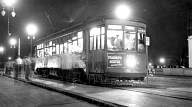 |
The last regularly scheduled streetcar on the Canal line was 958. It is seen here getting ready to leave the terminal at the foot of Canal Street for the last time, filled with fan riders, in the early hours of May 31, 1964. This was the last visit of any streetcar to this terminal. Normally, this run would have been to the cemeteries and then back to the car barn at Canal Station, but on this night, 958 pulled into the station on its final outbound trip, and yielded its passengers and the rest of its run to 972. — Collection of Michael Strauch (StreetcarMike.com) |
| Picture 383.5. | |
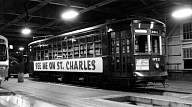 |
Car 972 was to be retained for the St. Charles line. For the last run of the Canal line, it was brought to Canal Station and outfitted with the poster seen here. — Collection of Michael Strauch (StreetcarMike.com) |
| Picture 383.7. | |
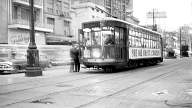 |
When 958 pulled into Canal Station car barn for the last time in the early morning of May 31, 972 took over the remainder of the last run out to the cemeteries terminal. It then returned inbound on Canal Street. NOPSI crew were out turning off the power to the overhead wires behind the 972 as it worked its way inbound. The photo shows the last car on Canal Street between Baronne and Carondelet. When it reached the next block, there was a brief ceremony, and the car then switched over to the St. Charles track and proceeded out the St. Charles line. — Collection of Michael Strauch (StreetcarMike.com) |
| Picture 384. | |
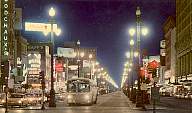 |
This 1970s night view of Canal St. features a Canal Street diesel bus in its private bus lane, which replaced the inner tracks in 1964. A daytime view shows many more buses in this area; see the next picture. |
| Pictures 385 and 386. | |
 |
The modern skyline of New Orleans, looking toward the river (apparently with a telephoto lens) from a few blocks out from Rampart Street. In the upper, earlier picture, note the familiar Loew's Theater sign at the near right. Canal Street buses in the neutral ground lanes are almost as frequent as the streetcars had been. But Maison Blanche is no longer the tallest building in the view. The Marriott Hotel has joined the great old hotels of New Orleans (for example, see the old St. Charles Hotel in Pictures 51 through 58, the newer St. Charles in Pictures 137 through 141, the old Royal in Pictures 152 through 156, the Monteleone in Picture 158, and the Grunewald in Picture 166, and note the Jung at the right in this picture). To the right, near the river on the uptown side of Canal Street, is the new International Trade Mart. The lower picture, postmarked July 1985, shows yet another prominent new high rise hotel, the Sheraton. — Grant L. Robertson (both) |
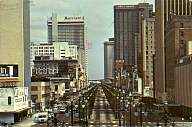 |
|
| Pictures 387, 388, and 389. | |
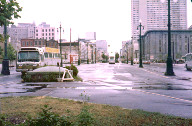 |
The foot of Canal Street near the Liberty Monument on a typical rainy summer day, Saturday, August 9, 1975. We see Canal buses making the loop to return out Canal Street. Notice the advertising on the “shoulders” of the General Motors “new look” or “fishbowl” diesel bus in the top picture. The entrance to the operator's shelter, apparently unchanged since streetcar days, is visible in the two top pictures. The bottom picture shows the Liberty Monument; the buses do not circle it, as the streetcars did, but turn just out from the monument. All three pictures look out, with the river to the photographer's back. Incidentally, the Liberty Monument became the subject of racial controversy in the 1970s. It was removed from Canal Street in 1990, ostensibly for street work, and was eventually re-erected in a less conspicuous place just off of Canal Street, near the Riverfront line. — Photos by the author |
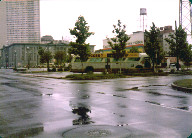 |
|
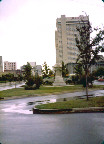 |
|
| Pictures 389.3 and 389.6. | |
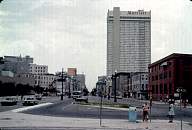 |
Patrons await the arrival of a Canal bus at the turnaround at Delta Street, and then board. The bus will swing around to its left to return out the neutral ground of Canal Street. This class of Flxible bus was purchased in 1967. These photos date from the late 1960s or early 1970s. The photographer's back is to the Liberty Monument and the River. — Photos by Earl Hampton |
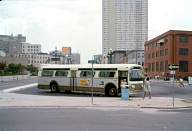 |
|
| Picture 390. | |
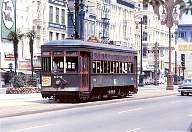 |
Perley Thomas car 972, last of its class, on the St. Charles line, in August 1968. The car is traversing the one remaining block of Canal Street trackage, the outer track from Carondelet to St. Charles Street. Note the conductor visible in the rear window. The car's upper windows have been rebuilt with rounded corners, but it still uses a two-man crew. — Photo by Joe Lance |
| Pictures 391, 392, and 393. | |
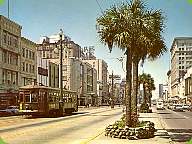 |
Three views of St. Charles streetcars on Canal Street, about 1972. When the Canal line was dieselized, 35 of the 900-series Perley A. Thomas cars were retained to provide service on St. Charles. They were rebuilt with modern materials and methods, and in 1972 were converted to one-man operation. One of the more obvious changes was the use of rubber mountings and rounded corners on the upper windows and doors. The windows were standard stock GMC bus parts. Note the bus lanes on the neutral ground, occupied by GMC and Flxible diesel buses serving the Canal Street lines. These views are looking out toward Carondelet/Bourbon. The bottom view, showing car 907, was taken Friday, September 15, 1972. — Mac Miller (middle); bottom view © 2001 Peter Ehrlich, used with permission |
 |
|
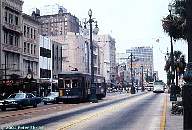 |
|
In 1997, it was decided to build new trackage connecting the Riverfront line with the St. Charles line, so that Riverfront cars could be housed at Carrollton Station. The Riverfront line had been opened August 14, 1988, using a section of standard gauge railroad line, and it was isolated from the rest of the track system. It had been operated with three Perley Thomas cars mounted on standard gauge trucks, and three second-hand cars from Melbourne, Australia, the latter being wheelchair accessible. The cars had been stored at the ends of the line, and had to be trucked to Carrollton Station for any serious shop work.
Now, new cars, replicas of the 900-series Perley Thomas cars used on the St. Charles line, and numbered 457 through 463, were built in Carrollton Station shops, with newly built bodies having complete wheelchair accessibility. (Car 457 used the body of Perley Thomas car 957.) Several retired PCC cars were obtained from Philadelphia, with the plan of using their trucks and controls in the new cars, and cars 457 and 458 were so equipped and tested. Also, a demonstrator car from the Czech company CKD (Tatra) was obtained and operated over the new trackage for a while. After testing, it was decided to equip the cars with new PCC-type trucks and controls from CKD, and the Philadelphia cars and equipment were sold or scrapped. (One Philadelphia car had actually made a demonstration non-revenue trip from Carrollton Station over the St. Charles line to Lee Circle and back, the only PCC car ever to operate in New Orleans.)
Wide gauge double track was built on Canal Street, using the bus lanes in the inner-track position, from Baronne/Dauphine to the foot of Canal, and connected to the Riverfront line, which was converted to wide gauge. (The last day of standard gauge operation was September 6, 1997, after which the line was closed and regauged, reopening with the new cars December 7.) Two crossovers, one in each direction, were installed between the riverbound inner and outer tracks between Carondelet and St. Charles Streets, and a crossover was installed between the two inner tracks between Baronne/Dauphine and Carondelet/Bourbon. A Riverfront car heading to the car barn (which is just off Carrollton Ave., on the St. Charles line) travels lakebound on Canal to Dauphine, switches back, and then switches to the outer track, finally turning up into St. Charles Street. Anticipating future needs, a three-track section was created near the foot of Canal Street, with a center “pocket” track useful for shuffling cars.
After years of discussion, plans were announced in the summer of 2000 for the restoration of streetcar service on the Canal line. The main line was to extend from the foot of Canal Street out to City Park Ave., just as it had before dieselization in 1964. There was also to be a branch line along N. Carrollton Avenue, which had never previously had streetcar service, to Esplanade Blvd. and City Park Ave. at Beauregard Circle. Ground was officially broken July 20, 2001, although the contract for track construction had not yet been let as of that date. Construction was divided into three segments: Baronne to Salcedo Streets, Salcedo to the Cemeteries, and the N. Carrollton branch line. Local oilman and philanthropist Patrick F. Taylor donated $1.2 million worth of surplus oilfield pipe to be used as support poles for the trolley wires. A prototype Perley Thomas replica car, number 2001, had been constructed in 1997, featuring wheelchair accessibility, air conditioning, and what was described as state-of-the-art control technology from the Czech Republic, including dynamic braking. In 2001, this car began operating a demonstration service over the Riverfront to St. Charles connecting tracks, from Baronne/Dauphine to the foot of Canal Street, for a 25 cent (one way) fare. Canal buses no longer used the neutral ground bus lanes. Twenty-three additional streetcars were constructed at Carrollton Station under the direction of Elmer Von Dullen to equip the Canal line. The Brookville Mining Equipment Corp. provided 23 sets of four-motor trucks, controls, and air conditioning units for the new cars. (More details on Brookville can be found on their web site www.bmec.com under Showcase.) The first of these cars was unveiled in mid-June 2002. As of September 16, 2003, an RTA announcement said that nineteen cars had been completed (counting the prototype, car 2001), and the last five were in the final stages of assembly. Ten of the new cars were stored temporarily under tarps on the Riverfront line tracks near the uptown Riverfront terminal. All of the new cars were moved later to the new car barn, known as the Service, Inspection, and Storage facility (SIS), at Canal Station.
To complete the picture of Canal Street trackage, the projected Desire line must be mentioned. This line was proposed to operate down N. Rampart Street and St. Claude Avenue into the area once served by the old Desire streetcar line. The proposed route would approximate a short form of the old St. Claude streetcar line. It would cross Desire and France Streets near its downtown (downriver) terminal. At its uptown terminal, it was proposed that the cars turn from the N. Rampart neutral ground to the Canal St. neutral ground, then proceed to Basin and go down Basin in the right-hand traffic lane (rather than the Basin St. neutral ground). The outbound Canal Street track between N. Rampart and Basin was built as a gauntlet track, with the rails for the Desire line actually between the rails for the Canal line. Thus, the cars would each move on their own rails, but would occupy essentially the same space in the neutral ground. The new Canal Street trackage has turnouts at N. Rampart and Basin Streets, and there are switches in the gauntlet track, so that cars going in either direction can turn from one line to the other. See CanalStreetcar.com, the page "Canal-Desire" (under the heading "the line"), for diagrams of this trackage. The stumbling block for this proposal was the Norfolk Southern railroad crossing on St. Claude Ave. at Press Street. Press reports that the railroad is concerned about safety of a freight railroad-streetcar grade crossing. It is not clear why this would be more unsafe than the old St. Claude line, which operated across a grade crossing at this point until 1949. Other reports point to the double-deck freight cars operated there; the trolley wire would be too low. In either case, the railroad insists on an under- or over-pass, which would be too expensive to be practical. A revised plan is under consideration which would end the line at Press Street.
| Pictures 413, 414, and 415. | |
 |
Prototype Carrollton-built Perley Thomas replica car 2001 in Canal demonstration service, at the pocket track near the foot of Canal Street, November 2001. Features of the new car that can be observed in these pictures include the fake clerestory roof, which houses air conditioning equipment, and the wheelchair door in the side of the car. The car is painted red and light yellow, like the Riverfront cars, but is signed and lettered like the St. Charles cars, with the route sign above the window and the car number below it. — Michael Strauch (StreetcarMike.com) |
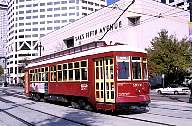 |
|
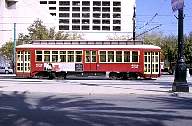 |
|
| Picture 416. | |
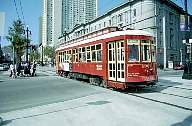 |
In November 2001, riverbound Canal demonstration car 2001 passes the Custom House
at Peters, just as countless earlier New Orleans streetcars (horse and electric) have
done. — Michael Strauch (StreetcarMike.com)
From about this point in to the river, Canal Street has been totally changed since the old Canal line was removed in 1964. Cross streets, buildings, and Canal Street itself have disappeared and been rebuilt. Much of this change was done for the World's Fair in 1984, with improvements since that time. |
| Picture 417. | |
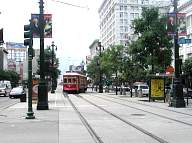 |
Canal car 2001 takes the crossover between Baronne/Dauphine and Carondelet/Bourbon to begin a demonstration run to the foot of Canal Street, Wednesday, August 6, 2003. At least on this date, demonstration service ran from this point riverbound to the pocket track, through the center pocket track to the opposite track, and as far riverward as the curve connecting to the Riverfront line, from which point the car returned to Dauphine St. — Photo by the author |
| Picture 418. | |
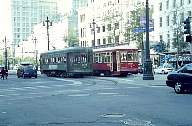 |
St. Charles car 907 and Canal car 2001 at the corner of Canal and St. Charles one afternoon in November 2001. Note the different roof on 2001, with the clerestory housing for the air conditioning. Despite the sultry climate, the new Canal cars are the first air conditioned streetcars in New Orleans. — Michael Strauch (StreetcarMike.com) |
| Picture 419. | |
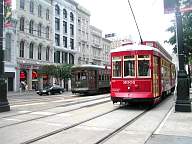 |
Perley Thomas car 969, beginning its upbound run on the St. Charles line, and Carrollton car 2001, outbound in Canal demonstration service, pass each other on August 6, 2003. — Photo by the author |
| Picture 420. | |
 |
Canal demonstration service car 2001 awaits the green light, outbound on Canal at Royal Street, August 6, 2003. — Photo by the author |
| Pictures 421 and 422. | |
 |
Two more Canal cars start out as body shells, already mounted on their trucks in the erecting bay at Carrollton Station, Wednesday, August 6, 2003. — Photos by the author |
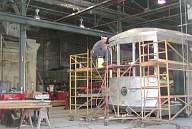 |
|
| Picture 423. | |
 |
Completed Canal car 2016 puts its face out into the sunlight from a storage track at its birthplace, Carrollton Station, August 6, 2003. That's Riverfront car 461 up on jacks on the track to the right of 2016. An unpainted car body can be glimpsed to the right of 461. — Photo by the author |
| Picture 424. | |
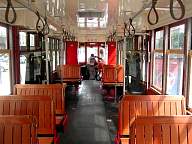 |
The interior of Canal car 2001, August 6, 2003. There is a wheelchair lift on each side of the car. Note also the flat interior ceiling, instead of the arched ceiling of the Perley Thomas and Riverfront cars; this is to make room for the air conditioning equipment. The seats are excellent replicas of those in the Perley Thomas cars. — Photo by the author |
| Pictures 425 and 426. | |
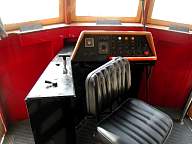 |
The operator's control stations in the Von Dullen cars. The upper picture was taken in the prototype car 2001 on August 6, 2003. The lower picture was taken in production car 2008 on March 18, 2005. For many years, streetcar motormen and conductors sat (when they could) on small, backless stools. Now in New Orleans, they have relatively luxurious padded seats with backs. (Customers still sit on wood slat seats.) On the left console in both pictures, the handle closest to the camera has three positions for reverse, off, and forward. The next handle serves to control both acceleration (push forward) and braking (pull back). The console under the center window contains switches for doors, lights, etc., and assorted warning lights to inform the operator of the condition of the car. In the lower picture, another box can be seen at the far right, which contains a microphone, a telephone-type handset, and controls for the car PA system. The production cars have a sliding cover for the panel, which is closed when control is at the other end of the car. Note the locks on the cover, the control handle, and the PA box on car 2008. The foot pedal operates an electrically-driven gong. — Photos by the author |
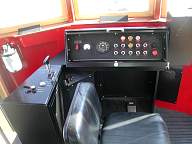 |
|
| Pictures 426.3 and 426.6. | |
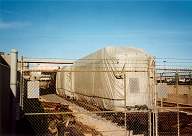 |
Several of the new Von Dullen cars were stored under tarps at the uptown end of the Riverfront line trackage. The upper picture shows the first three, looking downriver, with car 2005 in the process of being covered, and cars 2004 and 2003 in front of it. The lower picture, which is looking in the opposite direction, was taken a bit later; the nearest car in this picture is 2007 or 2008 under the tarp. Note in the lower picture that the trolley wire ends over the second car. Some of the cars were moved into storage position by coasting on wireless track. — Photos by Earl Hampton |
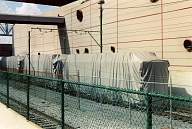 |
|
| Pictures 427 and 428. | |
 |
Construction in progress on Canal Street, Thursday, August 7, 2003. These pictures were taken from the intersection of Roman and Canal Streets, two blocks out from Claiborne Ave., where the overpass carries Interstate 10 traffic above grade. The top picture looks in toward Claiborne, and the bottom picture looks out. Note the steel poles set to carry the trolley wires. It is unusual in New Orleans for them to also support the street lights, as they are doing here. Span wires are strung between a pair of poles all the way from the river to this point, while center poles are the general rule from about the next street (Prieur St.) out toward the terminal. The tracks bend at Prieur to make a wider space (the devil strip) between them. (In the old trackage that was removed in 1964, that happened at Claiborne Ave.) The neutral ground is not as wide as it was up until 1964; the demands of automobile traffic have required its reduction. — Photos by the author |
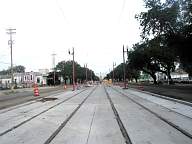 |
|
| Pictures 429 through 432. | |
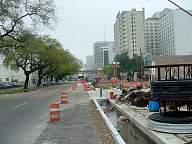 |
Construction in progress on Canal Street, March, 2003. These pictures were taken from the intersection of Tonti and Canal Streets. The top picture is looking in toward Claiborne Ave., and the other three pictures look out. (Tonti Street is seven blocks out from Claiborne, between Galvez St. and Broad Ave.) The switch in the foreground of the third and fourth pictures is one of the turnback crossover switches, used in emergencies such as the line being blocked somewhere. Note the concrete around the rails in the grassy neutral ground; this is a new track construction feature for New Orleans. — Erby Aucoin III |
 |
|
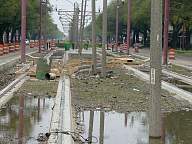 |
|
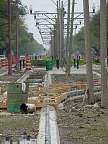 |
|
| Pictures 433 and 434. | |
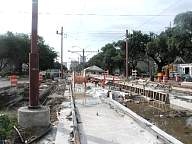 |
Canal Street construction near the new car barn at N. Gayoso Street, August 7, 2003. The top picture looks inward, the bottom picture outward. The connecting tracks to the new barn have not yet been completed. The overhead lines will be supported by span wires in this area. Note the tie-less track being laid in concrete. — Photos by the author |
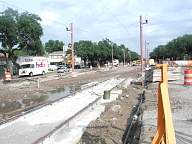 |
|
| Picture 435. | |
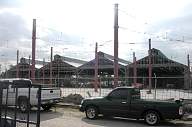 |
The new car barn, known officially as the Service, Inspection, and Storage facility (SIS), August 7, 2003. In a delightful bit of irony, this car barn began life circa 1924 as a bus garage. Tracks are being laid to pass through the width of the building. North Gayoso Street is in the foreground of the picture. Car 2013, one of the new Canal cars, was trucked to this trackage for testing, since the car barn tracks had not yet been connected to Canal Street. — Photo by the author |
| Picture 436. | |
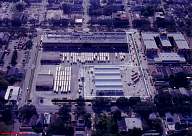 |
An aerial view of Canal Station, November, 2003, looking in the uptown direction. Canal Street crosses this picture left-to-right at the top, and N. Gayoso Street is at the right. The large building in the upper center, facing Canal Street, is the A. Philip Randolph facility, built in 1992 on the site of the original Canal streetcar barn. We see numerous diesel buses parked behind it. The building closer to the camera and just right of center, having four peaks on the roof, is the former bus garage now converted to streetcar service. (A band has been drawn around this building and the streetcar tracks leading to Canal Street.) About 13 streetcars, more than half the fleet, can be seen on the tracks. — Bob Rabito, Lagniappe Studio (www.lagniappestudio.com), courtesy of Edward J. Branley (CanalStreetcar.com) |
| Picture 437. | |
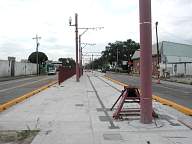 |
The end of track at Cemeteries Terminal, Canal and City Park Ave., August 7, 2003. The Canal Street neutral ground has always been narrower from Anthony St. to City Park Ave. This section, like all the rest of the street, has seen the neutral ground narrowed since the track removal in 1964. There is no longer room for a double track terminal. Between the switch seen in this picture and Anthony St., the inbound track runs in the left traffic lane, sharing it with automobile traffic. The switch is an example of something new in New Orleans track: a double-point streetcar-type switch. The bumper is also an unusual detail in New Orleans streetcar practice. — Photo by the author |
| Picture 438. | |
 |
A typical section of the new track along N. Carrollton Ave., August 7, 2003. The photographer is standing in the inbound (upbound) traffic lane, which will be shared by the streetcars and automobile traffic. Notice the separate line poles for the two tracks. The neutral ground of N. Carrollton Ave., and indeed S. Carrollton as far as Claiborne Ave., has been narrowed over the years; it is much wider between Claiborne and St. Charles, where the St. Charles streetcar line has always been. This is presumably the reason for the precedent-setting choice of putting the track in a traffic lane rather than on the neutral ground proper. — Photo by the author |
| Pictures 439 through 443. | |
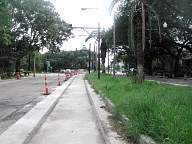 |
This group of pictures shows the track on Carrollton as the photographer approaches the Beauregard Circle terminal, August 7, 2003. The first picture is taken from the inbound (upbound) track, looking back toward City Park Ave. (the traffic light) and beyond to the Circle. The next two pictures show the point where the two tracks merge and enter the neutral ground for the last short stretch down to the Circle. The last two pictures show the divergence into two tracks at the terminal. The third and fifth pictures give good views of the new double-point streetcar-type track switches. General Beauregard's equestrian statue can be seen in the background of the last two pictures. — Photos by the author |
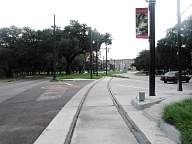 |
|
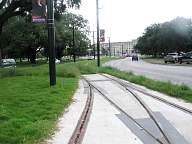 |
|
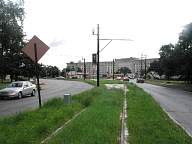 |
|
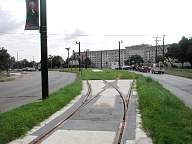 |
|
| Picture 444. | |
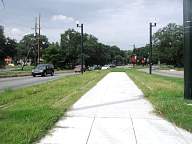 |
The photographer's back is to General Beauregard, so we are looking inbound (upbound) at the two layover tracks and the center loading platform. Carrollton Ave. at Beauregard Circle, August 7, 2003. — Photo by the author |
| Picture 445. | |
 |
A Canal Street operator-in-training changes ends on car 2004 at the Cemeteries Terminal, April 3, 2004. Behind the streetcar, we can see the cemeteries for which this terminal is named. — Edward J. Branley (CanalStreetcar.com) |
| Picture 446. | |
 |
The downtown terminal of the Riverfront Line was rebuilt to serve as the terminal for both the Riverfront and Canal lines. Plans call for inbound Canal cars to travel from Canal Street to this terminal over the tracks of the Riverfront line, with some runs turning back at the pocket track at the foot of Canal Street. The terminal, formerly called Esplanade and renamed French Market, now has three tracks. Canal car 2019, at left, is on the track intended for Canal cars going to Cemeteries terminal, and car 2014 is on the track intended for Canal cars going to Beauregard Circle; the middle track, vacant in this picture, is for Riverfront cars. Note the freight railroad track to our left. The Canal streetcars are showing "Out of Service" signs over the left-front window (as seen from the photographer's vantage point). The cars are being used for operator training prior to the opening of the Canal line in this March 28, 2004 picture. — Edward J. Branley (CanalStreetcar.com) |
Operation of the new Canal Street line began at 3:10 a.m. on Sunday, April 18, 2004, when car 2004, run 01, left the Randolph SIS Facility and turned lakebound onto Canal Street, picking up a huge load of first-run passengers to ride to the Cemeteries. There were so many passengers waiting that a second car, 2013, run X1, was immediately brought out to accomodate those who could not fit into 2004. It was reported that about 30,000 passengers were carried the first day, requiring 21 of the 24 new Von Dullen streetcars. (For comparison, the busy and longer St. Charles line carries about 15,000 passengers on a typical weekday.) The cars display a Canal route sign above the front center window, with a destination sign above the front side window showing either Cemeteries or City Pk/Museum. Officially, Canal-Cemeteries is RTA route 42, and Canal-City Park/Museum is route 45, but the route numbers are not displayed on the cars. According to the original published schedules, alternate cars (with a few exceptions) were routed to each destination.
Experience with this arrangement uncovered problems of congestion on the Riverfront trackage. By early 2005, the proportion had changed to one City Park/Museum car for each three Cemeteries cars, and the Cemeteries cars were terminated at the pocket track at the foot of Canal Street, without making the trip down the Riverfront track to the French Market station. Cemeteries cars carried a Canal route sign over the front center window, and a Cemeteries destination sign in the front side window on both ends of the car. City Park/Museum cars carried that designation over the front side window of the outbound end of the car, and a French Market destination on the inbound end of the car. Curiously, City Park/Museum cars carried a variety of signs over the center front window on both ends: sometimes Canal, but sometimes Riverfront, City Park, or even Carrollton. (There is not, and never has been, a streetcar route named Carrollton, and Riverfront and City Park are or were different routes.)
Operation at the pocket track, as observed in March 2005, is as follows. Cars bound for the Riverfront line and the French Market terminus take the rightmost track (as viewed from a riverbound car). Cars which intend to terminate at the pocket pull into the center track, discharge their last passengers, and take their layover. At departure time to begin the outbound run, they pull forward onto the left track (still heading for the river), change ends and trolley poles, and load passengers for the return trip.
| Picture 447. | |
 |
The very first streetcar to leave Canal Station in revenue service since 972 made the last run forty years previously. Von Dullen car 2004, run 01, leaves the station trackage for the outbound Canal Street track, 3:10 a.m. Sunday, April 18, 2004. — Philip Nami photo |
| Picture 448. | |
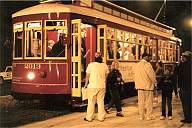 |
There were so many passengers for the first run that car 2013, run X1, was immediately brought out as a second section. Here is that car later in the morning heading inbound at Salcedo Street. Note that the car is loading from a center loading platform through the left front door, which is standard practice on the new Canal line outside of the central business district. — Philip Nami photo |
| Pictures 448.3 and 448.6. | |
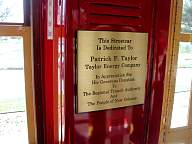 |
The top picture shows a plaque mounted in car 2004
recalling the Patrick Taylor gift of oil pipe to use in erecting the
supporting poles for the trolley wire on the new Canal line.
The text reads:
Is Dedicated To Patrick F. Taylor Taylor Energy Company In Appreciation For His Generous Donation To The Regional Transit Authority And The People of New Orleans Canal Streetcar Line are made from 7" oilwell casing Donated to the People of New Orleans by Patrick F. Taylor Taylor Energy Company April 18, 2004 — photos by the author |
 |
|
| Pictures 449 and 450. | |
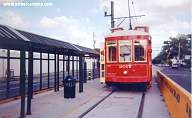 |
Von Dullen car 2017 at the Cemeteries Terminal on the first day of restored operation, April 18, 2004. The car is ready to return in on Canal. In the upper picture, note the inbound track in the traffic lane, glimpsed ahead just to the right of the car. The upper picture looks inbound, the lower picture looks back to the end of track. — Joseph Strauch (courtesy of Michael Strauch, StreetcarMike.com) (both) |
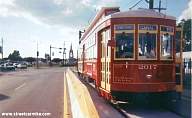 |
|
| Picture 451. | |
 |
Car 2018 loads passengers from the center platform through its left-hand door, inbound at Jefferson Davis Parkway, April 18, 2004. — Joseph Strauch (courtesy of Michael Strauch, StreetcarMike.com) |
| Picture 452. | |
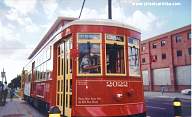 |
Car 2022 is signed for the Carrollton branch line to Beauregard Circle as it pauses on Canal Street in front of Canal Station and the Randolph SIS Facility to board passengers on the first day, April 18, 2004. — Joseph Strauch (courtesy of Michael Strauch, StreetcarMike.com) |
| Picture 452.5. | |
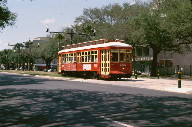 |
Von Dullen car 2002 is filled with passengers on the second day, April 19, 2004. Strangely, the RTA logo is being displayed instead of the Canal route sign over the center end window. The side window correctly displays the Cemeteries terminal designation. — Charles Sullivan |
| Picture 453. | |
 |
Von Dullen car 2020, outbound on Canal Street, has just passed Royal/St. Charles Streets. The track on the far right is the outer riverbound track, used by the St. Charles cars at the beginning of their upbound runs. — John Pappas |
| Picture 454. | |
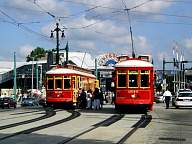 |
Car 2016, outbound at the left, and 2010, inbound at the right, pause at the pocket track at the foot of Canal Street, at the junction with the Riverfront line. Car 2016 has just come from the Riverfront trackage, and 2010 is about to enter that track on its way to the French Market (Esplanade) terminal. — John Pappas |
| Pictures 455 and 456. | |
 |
The “new” Canal streetcar barn (above) and its yard (below), officially known as the Service, Inspection, and Storage (SIS) Facility. Compare the under-construction view in Picture 435, and the aerial view in Picture 436. The steel arches over the tracks in the lower picture were salvaged from the old Canal Station car barn, when it was demolished in 1992 to make way for the A. Philip Randolph bus maintenance facility. — John Pappas (both) |
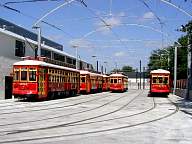 |
|
| Pictures 457, 458, and 459. | |
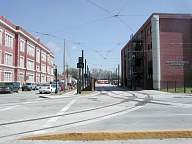 |
The Canal Station Randolph SIS Facility in regular operation, March 18, 2005. The top picture looks into the property from the Canal Street neutral ground. Note that the double-track connection from Canal Street to the car barn is located on RTA property, not in the cross street (at the left). The building to the left in the top picture is Warren Easton High School (see Picture 262). The building to the right is the A. Philip Randolph building. The ladder track in the foreground of the middle picture is the exit track from the car barn to Canal Street. — Photos by the author |
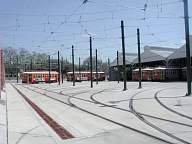 |
|
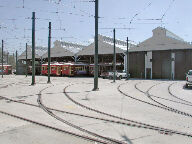 |
|
| Picture 460. | |
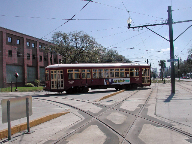 |
Riverfront car 458 pulls out of Canal Station heading for the river to start its operational day, March 18, 2005. Since the Canal line reopened, Riverfront cars have been housed at this facility, rather than in their original home at Carrollton Station. There is a special traffic signal which is actuated when a streetcar needs to cross the lakebound traffic lanes of Canal Street, as here, to stop the automobile traffic for the streetcar. — Photo by the author |
| Pictures 461 through 465. | |
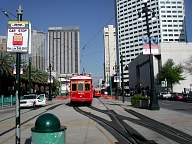 |
Operation at the pocket track at the foot of Canal Street on a typical weekday, Friday March 18, 2005, looking out toward the lake. In the top picture, car 2018, operating as Canal-Cemeteries run 10, pulls into the pocket track at the end of its run, while the previous car glimpsed at the right begins its run out Canal Street. The second picture shows car 2018 pulling forward onto the outbound track, where it will change ends and trolley poles and load passengers. Meantime, the next car, 2002, run 04, pulls into the pocket track. The third picture shows 2018 starting its run to the Cemeteries. In the fourth picture, 2002 takes its turn pulling onto the outbound track to prepare for its return trip. The bottom picture shows 2002 in the process of changing ends, with both trolley poles momentarily raised, as the next car, 2003, arrives at the pocket track. Note the car stop sign between the tracks, best seen at the left in the top picture; this is typical of the signs on the new Canal line. The automobiles on the neutral ground are RTA official cars. — Photos by the author |
 |
|
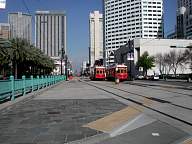 |
|
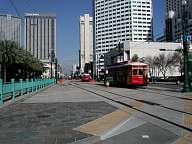 |
|
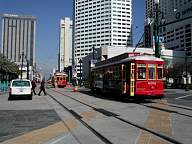 |
|
| Picture 466. | |
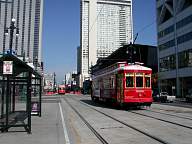 |
Canal-Cemeteries car 2002 stopped outbound (lakebound) at N. Peters, as an inbound (riverbound) sister car waits to cross Peters to its car stop (the shelter at the left). In the central business district, Canal cars load from the right side. Car stops are located every block here, with some stops being near-side and some far-side, apparently depending on the needs for automobile crossings of the neutral ground. Note the Custom House, in shadow, in the right background, now dwarfed by the high-rise hotels in the area. — Photo by the author |
| Picture 467. | |
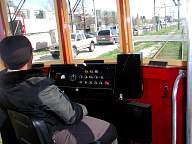 |
The operator's view as Canal car 2008 operates inbound (downbound) on the Riverfront trackage, toward the French Market terminal, Friday March 18, 2005. Note that there are windshield wipers on all three of the front windows. (The Perley Thomas cars on the St. Charles line have no wipers.) The Vieux Carré is to the left, and the river is out of sight to the right. — Photo by the author |
| Pictures 468, 469, and 470. | |
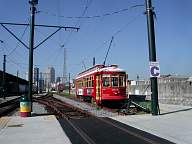 |
The French Market terminal looking uptown (upriver), Friday March 18, 2005. There are three terminal tracks: from the river (to our left), tracks A, B, and C. Signs designate track A for Canal-Cemeteries cars, track B for Riverfront cars, and track C for Canal-City Park cars. However, Canal-Cemeteries cars no longer come to this terminal—but no one has (yet?) changed the signs. Nonetheless, Riverfront cars use both tracks A and B. Tracks A and B are connected in a double scissors crossover, while track C has a separate crossover and connection to the other two. In the top picture, Canal-French Market/City Park car 2008 has just arrived on track C, and has both trolley poles up momentarily as the operator changes ends. In the bottom picture, Riverfront car 460 has just arrived on track A. The track to the left of track A is a standard gauge freight track. — Photos by the author |
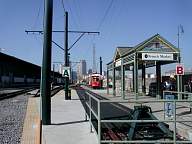 |
|
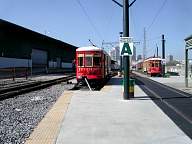 |
|
| Picture 471. | |
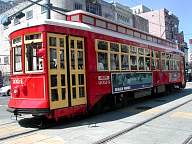 |
Von Dullen car 2024, the highest numbered streetcar ever to run in the Crescent City, operating as Canal-Cemeteries run 08, positively gleams in the sunlight on Canal Street in the central business district, March 18, 2005. — Photo by the author |
| Picture 472. | |
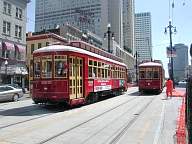 |
Canal-Cemeteries cars 2005, run 03, and 2011, run 01, pass on Canal Street in this March 18, 2005 view looking toward the river in the central business district. Car 2005 is loading passengers at its right front door, standard operation in the CBD. (Outside the CBD, most car stops are designed to use the left hand doors.) Note the New Orleans practice of hooking the rope of the front trolley pole off to the side, on the mount for the rear view mirror. — Photo by the author |
| Picture 473. | |
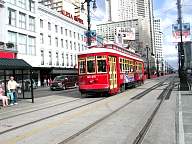 |
Canal-City Park/Museum car 2015, run 30, approaches the Bourbon Street stop heading outbound (lakebound), March 20, 2005. The switches at the right in the riverbound track connect the Canal line trackage to the St. Charles tracks in their one-block run on Canal Street. — Photo by the author |
| Picture 474. | |
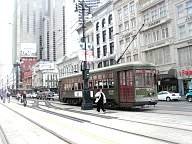 |
Two Perley Thomas St. Charles cars follow the outer track from Carondelet Street to St. Charles Street to start their upbound runs, March 20, 2005. The nearer car is 934, operating as St. Charles run 01. The farther car is making the turn to St. Charles Street, which it does while the traffic light is red for Canal Street automobile traffic. — Photo by the author |
| Pictures 475 through 478. | |
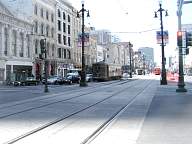 |
Perley Thomas car 923 on the St. Charles line has just turned in from Carondelet Street, and is about to turn up St. Charles Street, while a Von Dullen car is stopped at the traffic light at Bourbon Street. This scene is played out many times every day. But this time, March 18, 2005, is a bit unusual: ancient Ford Bacon & Davis (FB&D) car 29, only surviving car of its type, is following car 923 from Carondelet to Canal. Car 29 has recently gotten a complete refurbish, following a fire in one of its controllers. It is now painted in the same colors and style as the Perley Thomas cars, without “work car” striping on its front dash, as was seen in the past. The car is doing sand duty, travelling the lines sanding the rails for better traction. Instead of following car 923 up St. Charles Street, car 29 stopped at the crossover and turned back, taking the switch to the Canal line (second picture) and running "wrong way" into the next block. Fortunately for this maneuver, there happened to be a lull in Canal line streetcar traffic at this moment. The third picture shows car 29 stopped for the traffic light at Carondelet/Bourbon, facing the "wrong way"; the next St. Charles car is stopped on Carondelet Street at the left side of the picture. The bottom picture shows car 29 taking the crossover to the outbound Canal Street track, after which it headed out to Canal Station. Note the very wide clerestory roof on car 29, a characteristic of the FB&D car type. — Photos by the author |
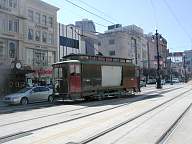 |
|
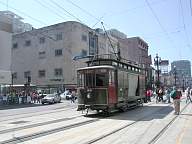 |
|
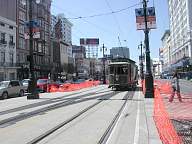 |
|
| Pictures 479, 480, and 481. | |
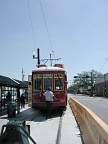 |
Canal-Cemeteries car 2005, run 03, has just arrived at its namesake Cemeteries terminus, March 18, 2005. In the upper picture, we see the operator, after having discharged his outbound passengers, moving to put up the front trolley pole, and in the second picture, we see him a moment later pulling down the other pole. Inside the car, he will reverse the passenger seats, lock the console on what is now the rear of the car, and unlock the front console, preparatory to loading passengers for the return trip to the foot of Canal Street. The bottom picture gives the view toward the river, showing the inbound track which runs in the automobile traffic lane in to Anthony Street, where it turns into the neutral ground. We can see the special traffic signals which stop auto traffic to allow the streetcar to safely enter the lane. — Photos by the author |
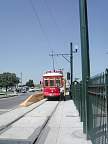 |
|
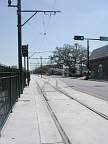 |
|
| Picture 482. | |
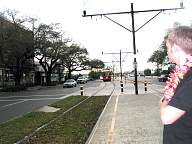 |
A passenger watches the approaching Canal-Cemeteries car from the loading platform at the Anthony Street stop. The picture looks out, toward the cemeteries. This shows the narrower part of Canal Street, between this point and the end of the street at City Park Avenue. The approaching inbound car is just about to leave the automobile lane for the neutral ground of the wider street, March 20, 2005. — Photo by the author |
| Pictures 483 and 484. | |
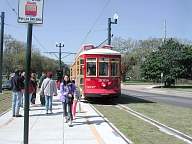 |
Canal car 2008, run number 33, arrives at the Beauregard Circle terminus of the City Park/Museum branch line, March 18, 2005. In the upper picture, the photographer is facing away from General Beauregard; the lower picture looks back toward the statue, in the background. That's the operator in the lower picture, walking back to the other end of the car to put up the other trolley pole for the return trip. Note the City Pk/Museum destination sign in the upper picture, and the French Mkt destination sign on the other end of the car in the lower picture. — Photos by the author |
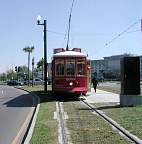 |
|
| Picture 485. | |
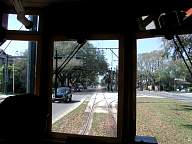 |
The operator's view of the track as the car, having left the Beauregard Circle terminus, prepares to enter the inbound (upbound) traffic lane on Carrollton Ave. The two terminal tracks converge to one for a short segment, and at this point the track diverges to double tracks in the street on each side of the neutral ground. Entry of the streetcar into the automobile lane is controlled by a special traffic light. — Photo by the author |
More pictures can be found at the
New Orleans page in the Streetcar Mike web site.
On August 29, 2005, Hurricane Katrina battered New Orleans, beginning a chain of events that resulted in massive flooding of large parts of the city. The result was the worst natural disaster in American history. This account is limited to the effect on the streetcar system and Canal Street.
The day before the hurricane was expected, all streetcar service was suspended, and the cars were returned to their stations. All of the Perley Thomas cars were at Carrollton Station, along with Riverfront car 461, which happened to be in the shop for painting. The other six Riverfront cars, and all twenty-four of the Canal cars, were at Canal Station, in the Randolph SIS facility. They were thought to be relatively safe — but no one had counted on the extensive flooding from breaches in the levees.
As it turned out, Carrollton Station was not flooded, and the cars stored there came through the ordeal intact. However, Canal Station was extensively flooded. The water invaded the bus maintenance facilities, resulting in a terrible mix of oil-polluted water on the site. Water five feet deep engulfed the buses and the streetcars, and they soaked in the corrosive mixture for several days. The result was complete destruction of the delicate electronic components of the red cars, along with bubbling of plastics and rusting of steel components. Once the site was drained and dried out, Riverfront car 463 and Canal car 2019 were shipped to Brookville for evaluation. It was estimated that the required rebuilding would cost about a million dollars per car, comparable to the original cost of their construction. Eventually, in 2006, RTA decided to rebuild the damaged cars in house, at Carrollton Station, their birthplace. A federal grant of $43 million was obtained to finance the rebuilding of the streetcars and the replacement of part of the destroyed bus fleet.
Once the floodwaters were drained, the tracks of the three streetcar lines were found to be intact, but the overhead system on the St. Charles line was severely damaged. Large sections were completely down, notably Lee Circle and parts of the line in the Garden District, and the old substation on Upperline Street was effectively destroyed. The Canal and Riverfront lines were usable, but had only one available streetcar. The power system for the Riverfront line was intact, but some of the rectifiers powering the Canal line were damaged.
The overhead system on St. Charles had been scheduled for rebuilding in September 2006, including the creation of two new substations in addition to the Upperline station. The rebuilding was hastily revised to include repair of the hurricane damage. It was estimated that St. Charles streetcar service would not be possible until the fall of 2006. That estimate was later revised to late 2007.
Meanwhile, RTA had perfectly usable streetcars from St. Charles, and usable streetcar lines on Canal and Riverfront. However, federal law requires ADA-compliant (i.e., wheelchair accessible) cars on these two lines. Given the extraordinary situation, permission was solicited and received to use the venerable Perley Thomas streetcars on Canal and Riverfront, despite their lack of wheelchair facilties. On Monday, December 12, 2005, car 930 was towed over the St. Charles tracks to Canal Street and used for testing operation over the Canal and Riverfront lines. The test was completely successful, and cars 915, 920, 923, 940, 947, 961, and 965 were towed to Canal to join 930. (Later, additional cars were also brought down to Canal Street.) Initially, three of the eight cars were used on Riverfront, three more operated on Canal from Crozat Street to the French Market terminal on Riverfront, and two others were available as substitutes. The cars were to be stored and serviced at the terminals on Riverfront. Service began on Sunday, December 18. Service on Canal beyond Crozat was held up until a replacement rectifer could be installed to restore power to the rest of the Canal line.
Eventually, a portable substation was found in Boston, and the Massachusetts Bay Transportation Authority generously made it available to New Orleans. The RTA mounted it on a concrete slab on the White Street side of the Canal Station property, still with its Boston T logos. After extensive testing and correction of some problems, the substation was placed in service at the end of March, and service with Perley Thomas streetcars over the entire Canal line, including the Carrollton branch, was resumed on Sunday, April 2, 2006. This marked a return of the PT cars to their old route on Canal, and a first-time-ever use of them on N. Carrollton Ave. Four cars were assigned to Canal St. service, two to Cemeteries terminal and two to City Park terminal (Carrollton branch), giving about a 25 minute headway. All cars operated through to the French Market terminal on Riverfront. The Boston substation operated until some time late in 2008, when it was replaced by a permanent substation installed by RTA on White Street near the former site of the portable.
In order to provide wheelchair service on Canal Street, supplementary bus service on the Canal-Cemeteries route was also provided. The bus route was given route number 42, and the streetcar service was designated route 47 to Cemeteries, and route 48 to City Park (N. Carrollton to Beauregard Circle). As before, the route numbers are not displayed on the streetcars.
In the meantime, the one operable Riverfront streetcar, 461, was taken into the paint shop at Carrollton Station and repainted blue with yellow trim! The arrangement of details was changed from the Riverfront standard—car number above the front center window, route name painted across the dash—to the New Orleans standard for all other routes—car number on the dash below the center window, route name on a roll sign above that window (although for the time being, the route name space was left blank). The car ran for a while on Riverfront, but when a problem arose with its controls, it was sent back to the station, and it was then withheld from service. It was reported that parts for the CKD (Tatra) trucks and controls were not available, and that they would be replaced. It was planned to repaint the car in the red livery before it is run again.
Service on the St. Charles line was provided by bus while the overhead and power system for the streetcar line was rebuilt. On December 19, 2006, streetcars returned to the part of the St. Charles line between Lee Circle and Canal Street, with a shuttle car operating from Canal and Carondelet, via Canal Street, then up St. Charles Street to Lee Circle, and back down Howard Ave. and Carondelet Street to Canal Street. A new substation was built beneath the Crescent City Connection at Calliope Street, and the Upperline power substation was rebuilt. This allowed streetcar service to be restored to Napoleon Ave. on November 11, 2007. Further extension to Riverbend, the corner of St. Charles and Carrollton, was accomplished on December 23, 2007. Full resumption of service to Carrollton and Claiborne had to wait on creation of another new substation, located at Carrollton Station, and was finally inaugurated on Sunday June 22, 2008.
In early December 2007, it was reported that Brookville Equipment Co., the company which had provided the trucks and control systems for the 23 production Von Dullen Canal cars, had been given the contract for the components necessary to rebuild all 31 damaged streetcars: the 24 Canal cars and all 7 Riverfront cars, including the 461. Installation, including rewiring of the cars, was to be done on site at Carrollton Station shops. Repainting of the cars at Carrollton was already under way. It was stated that the trucks would be remanufactured at the BEC facility in Brookville, PA. The project began in early 2008, and was expected to take three years. Carrollton Station was so busy, and so filled with cars being reconstructed, that the St. Charles line continued to be operated out of the Canal Station SIS facility.
The red Von Dullen (2000 series) cars finally began to return to service on the Canal and Riverfront lines on Friday, December 12, 2008. By that date, six red cars were ready for service, four of which were 2008, 2009, 2010, and 2013. Initially, one was assigned to Riverfront, which for the first time used 2000-series cars instead of 457-series cars. Two cars were assigned to Canal-City Park, the N. Carrollton branch line (route 48). Canal-Cemeteries (route 47) continued to operate with five Perley Thomas 900-series cars, plus school and rush hour trippers. The red cars were deemed most necessary on N. Carrollton Ave., where the tracks are in the left lane of the street, and the lack of left-front doors was most problematic. Later, a second red car was assigned to the Riverfront line, and on January 25, 2009, another car was added to Canal-Cemeteries. By this time, at least some of the Canal-Cemeteries cars were Von Dullen cars, because on this date, the Canal-Cemeteries bus (route 42) was discontinued; it had operated up to that time to provide wheelchair service on Canal Street. At first, all cars were operated through to the French Market terminal at Esplanade Avenue, but beginning January 25, Canal-Cemeteries cars were once again terminated at the pocket track at the foot of Canal Street. As of mid-January 2009, cars 2004 and 2008 through 2015 were all available for service. Additional cars were projected to be completed at the rate of one or two per month, with 2016, 2017, and 2018 expected by the end of February. Car 2019 was reported to have returned to New Orleans from Brookville some time in the year 2008.
As of mid-April 2009, all Canal Street and Riverfront service was being provided by Von Dullen cars 2004 and 2008 through 2023. The remaining 2000s were scheduled for completion in the next few months. By mid-June, the last few cars were the 2003, 2005, and 2006. Cars 457-463 were scheduled to be refurbished next. Perley Thomas cars were no longer seen in service on Canal Street or Riverfront, although they were still housed at Canal SIS, and the St. Charles car line was operated from that facility rather than from Carrollton Station.
The result of the rebuilding is that all of the red “Perley Thomas replica” Von Dullen cars (2001-2024 and 457-463) have the same trucks and controls: Brookville trucks with upgraded Saminco drives and TMV control systems.
In July 2009, streetcar service on Canal Street was shut down (with bus replacement) for what was expected to take two months, while underground electrical lines damaged by Hurricane Katrina's floodwaters were replaced. During this period, the St. Charles and Riverfront cars were housed at Carrollton Station, and those two lines were operated normally from there. After the return of the Canal Line to service, St. Charles cars continued to operate from Carrollton Station.
| Picture 486. | |
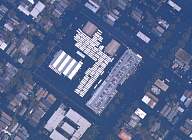 |
The central square of this satellite picture, shown tilted, is flooded Canal Station, the A. Phillip Randolph Transportation Center. The main building is the large block to the lower right of center. The streetcar Service, Inspection, and Storage facility (SIS) is at center left. A row of streetcars can be seen peeking out of the front doors. The white rectangles filling the yard are diesel buses. Canal Street runs from the upper right to the lower center of the picture. The floodwaters show up almost black, surrounding everything. — National Oceanic & Atmospheric Administration (NOAA) photo |
| Picture 487. | |
 |
Looking down on the SIS facility and the flooded streetcars peeking out through its front doors, Sept. 10, 2005. The cars with machinery on the roofs are the air-conditioned Canal Street cars. The ones with plain roofs are the Riverfront cars. — AP Photo/Smiley N. Pool |
| Pictures 488 through 491. | |
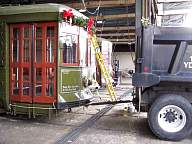 |
It is December 12, 2005, and Perley Thomas car 930, decorated for the Christmas holidays, is ready to be towed to Canal Street. However, the first tow bar tried was too short, and broke as the car was leaving the barn. A longer tow bar was then used with the Dodge Ram truck, and this was successful. The bottom picture shows car 930 on Canal Street at St. Charles, with its trolley pole taking power for the first time since the hurricane. The route sign still reads St. Charles, but the car is on the Canal line tracks. — Mike Pierson photos |
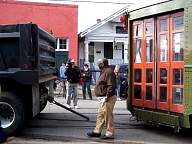 |
|
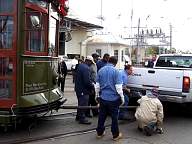 |
|
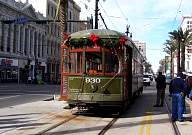 |
|
| Pictures 492 through 496. | |
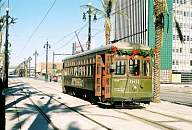 |
Earl Hampton captured these Perley Thomas cars the day after Christmas 2005, wearing their holiday decorations. The top picture shows car 961 on Canal at Liberty. This is the temporary outer terminal of the Canal line, between Liberty and Crozat. The operator has already changed trolley poles, and the car is waiting to take the crossover to begin its return trip. The second picture shows car 915 outbound at Basin Street. In the third picture, we see car 915 inbound turning from Canal into Riverfront, heading toward the French Market terminal. The fourth picture features cars 961 and 930 at the French Market terminal on (left to right) tracks B and A; the track closest to the camera is the standard gauge track of the freight railroad. The roof of the terminal shelter can be seen behind the streetcars, and a corner of the old mint building can be seen in the left background. The bottom picture shows car 965 waiting for passengers on track B at the terminal shelter. — Earl Hampton photos |
 |
|
 |
|
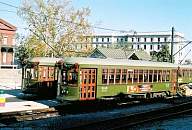 |
|
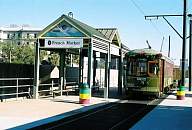 |
|
| Pictures 497 through 500. | |
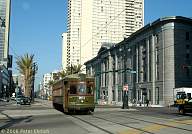 |
In the top picture, green Perley Thomas car 961 is inbound toward the river, passing the Custom House at Peters, just as it had done for many years prior to the ending of the original Canal line in 1964. The second picture shows car 947 outbound, turning from Riverfront onto Canal Street, in front of the aquarium. In the third picture, we see car 961 on Riverfront, with the St. Louis Cathedral in the background. These three pictures were taken January 11, 2006. The bottom picture shows us that Canal Street is coming back to life after the hurricane and flooding. It features car 930 on Canal at Bourbon Street, outbound, the evening of January 10, 2006. Note that the route signs show Special; the Perley Thomas cars no longer carry Canal on their roll signs (and never have carried Riverfront), since no one imagined they would ever run on Canal Street again. — All © 2006 Peter Ehrlich, used with permission |
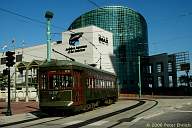 |
|
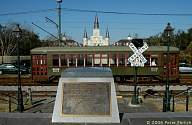 |
|
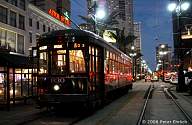 |
|
| Pictures 501, 501.3, and 501.6. | |
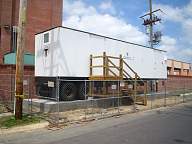 |
This is the White Street side of the Canal Station property. In the top picture, the portable substation, on loan from Boston, proudly displays its Boston T logos, April 2, 2006. In the middle photo, we see the empty slab on January 7, 2009, after the substation had been returned to Boston. The bottom picture shows the permanent substation installed on White Street nearby. — top photo by Earl Hampton, middle and bottom photos by the author |
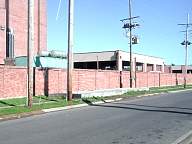 |
|
 |
|
| Picture 502. | |
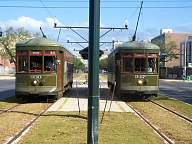 |
It is midafternoon on April 2, 2006, as Perley Thomas cars 930 and 947 meet along Canal Street. The route signs show Special, since the cars still do not have Canal line signs. If you know the code, you can tell which branch of the line each car is serving: run numbers in the 30s go down the Carrollton branch to City Park, while the lower run numbers operate to the Cemeteries terminal. Another problem evident in this picture is that the passenger loading platforms along most of the line outside the central business district were designed for use from the left-hand doors on the cars. However, since their conversion to one-man operation in the 1970s, the Perley Thomas cars have no control over the left-hand doors at the front of the cars. So either passengers must walk around the car and board precariously at the right-front door, or the motorman must walk to the back of the car to operate the left-rear doors. But everyone “makes do” with the situation. — Earl Hampton photo |
| Pictures 503 and 504. | |
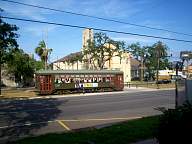 |
Car 947 cruises down its old stomping grounds along Canal Street, midafternoon of April 2, 2006. This sight was last seen in 1964! — Earl Hampton photos |
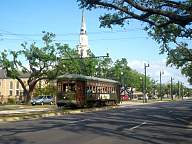 |
|
| Picture 505. | |
 |
Car 923 is leaving the Cemeteries terminus, moving into the riverbound automobile lane for the short trip to the wider part of Canal Street at Anthony Street, just after noon on April 2, 2006. — Earl Hampton photo |
| Picture 506. | |
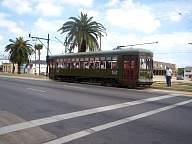 |
It is early afternoon on April 2, 2006, as car 965 negotiates the left-hand automobile lane of N. Carrollton Avenue. This marks the first day ever for Perley Thomas cars to operate revenue service on N. Carrollton. The man on the neutral ground is giving directions on the use of the new traffic signals at the intersection of Canal and Carrollton. There is now a push button that the motorman must use to get a signal to turn from Canal to Carrollton or the reverse. — Earl Hampton photo |
| Pictures 507 and 508. | |
 |
NORTA car 461 shows off its new blue livery at the French Market terminal of the Riverfront line, Sunday April 2, 2006. Several green Perley Thomas cars are keeping it company. — Kevin Pedeaux photos |
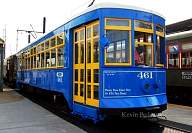 |
|
| Picture 509. | |
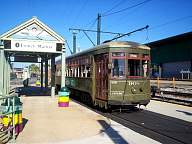 |
Perley Thomas car 968 lays over at the French Market terminal on the Riverfront line, awaiting its next run out Canal Street to City Park terminal on Carrollton Ave., October 7, 2006. — Earl Hampton photo |
| Picture 510. | |
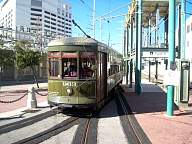 |
No one has changed the roll sign on car 963, which still says St. Charles, even as it turns from Riverfront to Canal, October 7, 2006. — Earl Hampton photo |
| Picture 511. | |
 |
Car 930 stops for passengers outbound on Canal Street at Bourbon, October 7, 2006. — Earl Hampton photo |
| Pictures 512 and 513. | |
 |
Car 968 pulls up to a stop along N. Carrollton Ave., October 7, 2006. Since the car is running in the leftmost automobile lane, there is no choice but for the operator to walk to the rear and load passengers from the left rear door. — Earl Hampton photos |
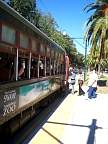 |
|
| Picture 514. | |
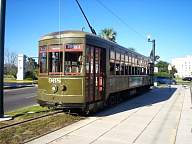 |
Car 968 has just pulled into the terminal at Beauregard Circle on Carrollton Ave. at City Park Ave., October 7, 2006. — Earl Hampton photo |
| Pictures 515 and 516. | |
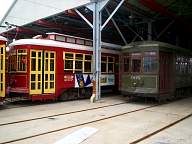 |
Damaged and out of service, Canal car 2017 and Riverfront car 459 look out from the doors of Canal Station SIS, along with Perley Thomas car 968 awaiting its next run, June 15, 2006. The damage to the windows of 459 happened as it was being shuttled around the yard at Canal Station. — Earl Hampton photos |
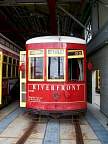 |
|
| Pictures 517 and 518. | |
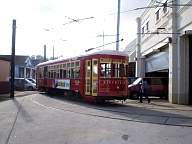 |
Riverfront car 460 is shuttled around at Carrollton Station as it awaits the beginning of its rebuilding, September 11, 2006. Note how part of the overhead system at Carrollton Station has been removed, to be eventually replaced in the rebuilding. Even the wires which remain, however, are unpowered at this time. — Earl Hampton photos |
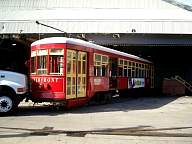 |
|
| Picture 519. | |
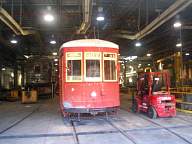 |
Riverfront car 457 shows off its damaged paint in this picture taken November 27, 2006 at Carrollton Station. That's Perley Thomas car 907 up on jacks to our left from car 457. — Earl Hampton photo |
| Picture 520. | |
 |
In the midst of all the recovery from Hurricane Katrina, movies continued to be made. One movie company came to town to film pictures of St. Charles Belt cars in their original habitat. Perley Thomas car 948 had its number repainted to 426, to act the part of one of the 400-449 series Southern Car Co. cars that ran on the St. Charles and Tulane Belts until 1948. The biggest giveaway of the masquerade, however, is that the 400-class cars had sliding front doors, not folding ones. The acting car is seen here resting at Carrollton Station on November 27, 2006, still wearing its “makeup”. — Earl Hampton photo |
| Picture 521. | |
 |
Perley Thomas car 911 in evening service on the Canal line, December, 2006. By this time, new route signs had been made up, at least for this one car, so that at long last, the car is displaying a route sign appropriate to its assignment. Note the festive decorations for the holiday season. — Dora Lyn Remy photo |
| Pictures 522 and 523. | |
 |
It was January 8, 2007 when photographer Earl Hampton toured the Canal line. Here we see Perley Thomas car 965 in its Christmas decor working on the Carrollton branch line to City Park. The second picture is at the Beauregard Circle terminal. — Earl Hampton photos |
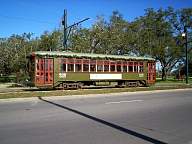 |
|
| Pictures 524, 524.3, and 524.6. | |
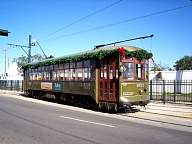 |
Car 953 is seen pulling out of the Cemeteries terminal to
begin its trip to the French Market terminal, January 8, 2007. It is just
entering the left traffic lane, shared with automobiles, for the brief trip to
the wider neutral ground at Anthony Street.
A small plaque can be seen on the side of 953 just behind the car number. The second picture is a closeup view of the plaque. It reads:
THIS ST. CHARLES STREETCAR WAS The third picture shows the stamp, Scott catalog number 2062, depicting car 953 as it looked in 1983 (notice the round door windows). — Earl Hampton photos |
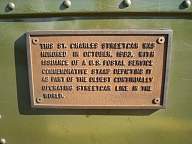 |
|
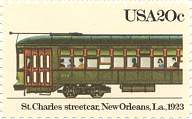 |
|
| Picture 525. | |
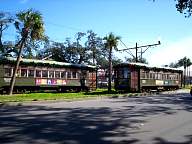 |
Cars 911 and 965 pass along Canal Street, January 8, 2007. — Earl Hampton photo
Although Picture 521 shows car 911 with a Canal route sign, none of the streetcars seen by photographer Hampton this day (including 911) displayed anything but a blank or the word Special in the route sign window. |
| Pictures 526 and 527. | |
 |
Here again are Perley Thomas cars 911 and 965, in the central business district of Canal Street, January 8, 2007. In the upper photo, car 911 is stopped for the traffic light outbound (lakebound) at the Carondelet/Bourbon intersection, and in the lower, car 965 is inbound (riverbound) in front of the Custom House. Note the newly planted palm trees at the Custom House; compare this view to that in Picture 497. — Earl Hampton photos |
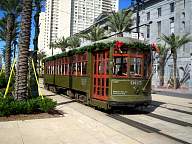 |
|
| Pictures 528 and 529. | |
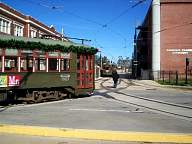 |
It is about 1:00 p.m. on January 8, 2007, and for some reason, car 911 is being taken to the car barn and swapped with car 906. We see here 911 pulling into the car barn trackage from the inbound Canal Street track, with 906 waiting in the background, and then 906 (still showing a Not In Service sign on its dash) pulling out across Canal Street to the inbound main track. Christmas is past, and 906 has been shorn of its holiday decorations. — Earl Hampton photos |
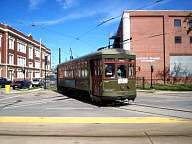 |
|
| Pictures 530 and 531. | |
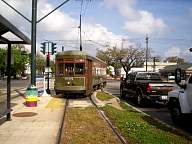 |
Outbound cars 965 (above, on March 29, 2007) and 930 (below, on March 8, 2007) turn from Canal Street into N. Carrollton Ave. as automobile traffic waits for the red light. — Earl Hampton photos |
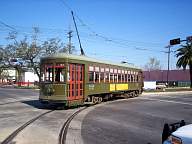 |
|
| Picture 532. | |
 |
Perley Thomas car 903 is leaving the cemeteries terminal, May 23, 2007. The car is pulling into the left automobile lane for the short trip to the wider part of the street at Anthony St., where it will turn into the neutral ground. — photo by the author |
| Pictures 533 through 539. | |
 |
In this series of pictures, we follow car 932 as it leaves
the City Park terminal at Beauregard Circle and travels up N. Carrollton Ave.
to Canal Street. The date is May 23, 2007.
In the top picture, we see the car just leaving the terminal, operating over the short stretch of single track. In the second picture, the car waits for the traffic light, and in the third, it begins to move into the inbound main track. In the fourth picture, the car has passed the photographer, who has turned around to face the rear of the car. The fifth picture shows the car stopped for a traffic light on its way up N. Carrollton Ave. The car turns from Carrollton into Canal Street in the sixth picture. There is a special traffic signal to govern this turn. The last picture features a closeup of the rear of the car after it has completed the turn onto Canal Street. The little white sign attached to the window says City Park, and is the nearest thing to a destination sign in use on the cars. — photos by the author |
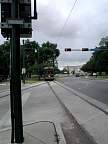 |
|
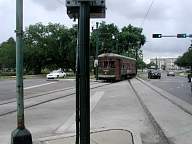 |
|
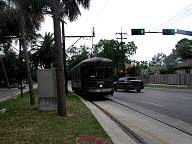 |
|
 |
|
 |
|
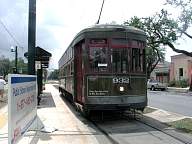 |
|
| Pictures 540 through 542. | |
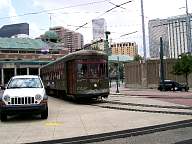 |
Perley Thomas car 969, operating on the Canal line, May 24, 2007, is turning into the Riverfront trackage at the foot of Canal Street. The second picture shows how the car boards passengers at the Canal Street Riverfront car stop, which was designed for left-hand doors. The Perley Thomas cars are not currently configured to use their left-hand doors, so the car stops short of the regular stopping point and loads and unloads passengers using the crosswalk. The third picture, taken as the car pulls away from the stop heading for the French Market terminal, shows how it is impractical to use the right-hand doors once abreast of the regular stop. — photos by the author |
 |
|
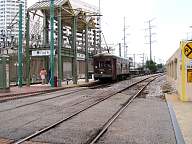 |
|
| Pictures 543 and 544. | |
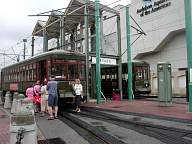 |
Cars 954, on the Canal-Cemeteries line, and 932, on the Canal-City Park line, meet at the Canal Street Riverfront stop, May 23, 2007. Outbound car 954 is loading passengers through the right front door from the walkway around the car stop. Inbound car 932 has pulled up too far to do that, so the operator has elected to come to the rear of his car and load from the left rear door. Note the sign proclaiming this car stop to be Canal Station! Unfortunately, that name also designates the car barn on Canal Street, although NORTA tends to refer to the entire car barn complex, traditionally called Canal Station, by the name given to its largest building, the A. Philip Randolph building. — photos by the author |
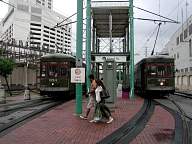 |
|
| Pictures 545 and 546. | |
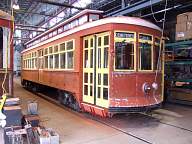 |
The date is February 12, 2008, and repainting of the 2000-series Von Dullen cars is well under way. These two pictures take a brief look at the process. The upper picture shows one of the cars with its old paint sanded down and dings patched up. The lower picture shows a car in the paint shop, just after being given its initial primer coat. — Earl Hampton photos |
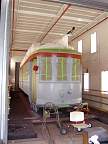 |
|
| Pictures 547, 548, and 549. | |
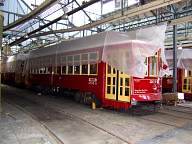 |
After the cars have been repainted, they are stored inside at Carrollton Station. Unfortunately, the upper rafters of the carbarn are home to an assortment of birds, which no one has been able to convince to move out. So to protect the newly painted cars, especially their roofs, they are covered in plastic sheets until the time when they will be ready to move again. The first picture features car 2014. The second looks at car 2020, up on a lift so that it can be separated from its trucks. The third is centered on car 2003, with more Von Dullen cars all around. — Earl Hampton photos, February 12, 2008 |
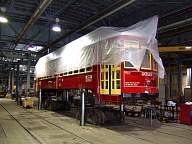 |
|
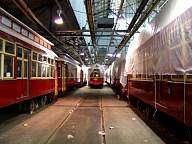 |
|
| Pictures 550, 551, and 552. | |
 |
It is June 3, 2008 at Carrollton Station Shops, and car 2008 is on its way to becoming the first post-Katrina rebuilt Von Dullen car. It is seen standing on its newly rebuilt trucks from Brookville Equipment Co. It appears that 2004, which inaugurated service on the restored Canal Line in the year 2004, will be the second car. It is seen up on jacks for underbody work. The third picture is a closeup of one of the brand new rebuilt trucks. Notice the track brake between the wheels. — Earl Hampton photos |
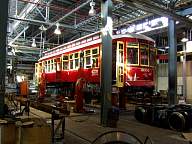 |
|
 |
|
| Pictures 553 through 557. | |
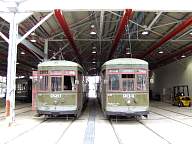 |
When the carbarn at Canal Station (the Service, Inspection, and Storage Facility) was being built, it was expected to house the red Canal and Riverfront Von Dullen cars. Here we see it as home to the green Perley Thomas cars, which in more normal times would never have ventured here from the St. Charles line and Carrollton Station. The first picture shows cars 920 and 934 peeking out the front of the building, with 905 at the left rear. The second view is from the other direction, and shows off cars 910, 905, and 972. The third picture is of the outdoor storage tracks, with cars 968, 953, and 922 in view. Note the metal arches over the outdoor tracks; these were salvaged from the old Canal Station carbarn when it was torn down to make room for the A. Philip Randolph building. These three pictures show the Storage aspect of the SIS. The fourth and fifth pictures show the Inspection and Service aspects. We are looking at cars 971 (fourth picture) and 965 (fifth picture) standing over the modern service pit for inspection and servicing of their underbody components. Most of the streetcars display a St. Charles or a blank route sign; there are no Canal or Riverfront selections on the roller. — top four photos by Earl Hampton, March 18, 2008; fifth photo by the author, January 7, 2009 |
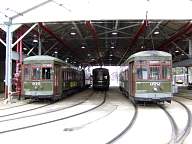 |
|
 |
|
 |
|
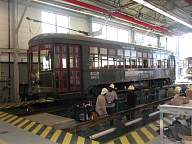 |
|
| Pictures 558, 559, and 560. | |
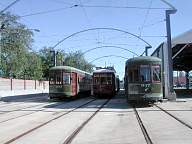 |
Refurbished Von Dullen car 2010 is flanked by Perley Thomas cars 934 and 947 in the yard of the Canal SIS facility, January 7, 2009. Behind the SIS, car 926 sits on the ladder track leading into the car barn and the yard. — photos by the author |
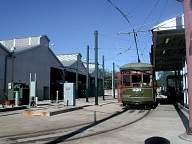 |
|
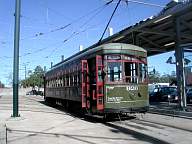 |
|
| Pictures 561, 562, and 563. | |
 |
It is January 7, 2009, and car 2008 is finally back in service on the Canal-City Park line. The top picture shows the car turning from Canal Street into N. Carrollton Avenue on its outbound trip, and the second picture shows it returning to Canal Street. The third photo gives us a closer look at the front of the refurbished car. Carrollton Shops has done its best work, and the car is as good as new. — photos by the author |
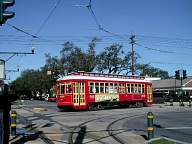 |
|
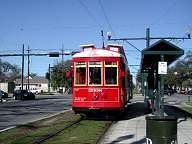 |
|
| Pictures 564, 565, and 566. | |
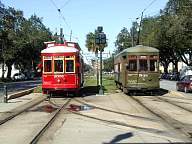 |
For a while, meets between red Von Dullen cars and green Perley Thomas cars were common, but that ended when enough Von Dullen cars were back in service to take over the Canal line completely. So here are meets from January 7, 2009, along Canal Street. The top picture features inbound Von Dullen car 2008 and outbound Perley Thomas car 948 at Gayoso Street near Canal Station. The second picture shows a meet between inbound 948 and outbound 2004 at Carrollton Avenue. The third picture stars green car 962 and red car 2008. In each case, the red Von Dullen car is serving the Canal-City Park line, and the green Perley Thomas car the Canal-Cemeteries line. The second picture shows the problem with the doors of the Perley Thomas cars: as presently configured, the left front doors cannot be opened to board passengers from the concrete pad between the tracks, and passengers must stand between the neutral ground curb and the car in order to board. In the Von Dullen cars, in contrast, the operators have control over all four doors, and can board and alight passengers from the concrete pad, as the car stop was designed to be used. — upper photo by Earl Hampton, middle and lower photos by the author |
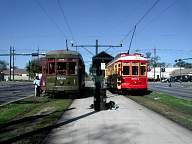 |
|
 |
|
| Pictures 567 and 568. | |
 |
Here are two more red-green meets, taken January 20, 2009, both featuring Perley Thomas car 962 serving Canal-Cemeteries. The top picture shows Von Dullen car 2010, and the second picture car 2011, serving the Canal-City Park branch. — photos by Earl Hampton |
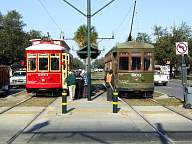 |
|
| Pictures 569 and 570. | |
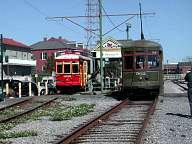 |
The red and the green met along Riverfront, too. Here is a picture of Riverfront car 2012 and Canal-Cemeteries car 962 on the Riverfront trackage at the Dumaine St. station. The lower picture shows a closeup view of 2012. — photos by the author |
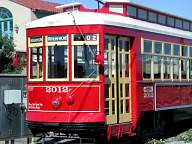 |
|
| Picture 571. | |
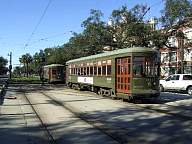 |
What happens when a car is a bit out of adjustment? During the day on January 7, 2009, car 911 developed minor brake trouble. The operator radioed ahead, and when he came past Canal Station, car 921 was waiting as a replacement. After the passengers and operator changed cars, 911 was taken into the SIS facility, and its brakes were adjusted. It was later observed back in operation the same day. — photo by Earl Hampton |
| Picture 572. | |
 |
This pair of Perley Thomas cars was observed January 7, 2009. Car 921, in the lead, stopped near a school on its inbound run, and waited a few minutes until students left the school and boarded the car. Car 945, following, had come out from the car barn to the end of the line, then followed 945 to the school. Once classes let out, both cars filled pretty quickly and then continued inbound. — photo by the author |
| Pictures 573 and 574. | |
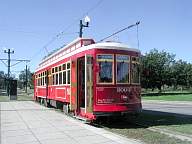 |
Here are pictures of Canal-City Park car 2004 at both ends of its run, January 7, 2009. The top picture shows the car at Beauregard Circle, the City Park-Museum end of the N. Carrollton branch line. The car has just arrived, and the operator has not yet changed ends and trolley poles. The second picture shows 2004 on the pocket track at the foot of Canal Street. The operator, who is standing between the two cars, has just finished transferring her remaining passengers to Canal-Cemeteries car 962 for the trip to the French Market terminal. Car 2004 had a problem with the trolley rope on the visible end of the car, so the run was cut short at the pocket track. Eventually, a NORTA supervisor was able to repair the problem, and the car returned outbound on Canal from this point. Note the casual NORTA practice about route signs: on one end, this car was showing a Canal route sign, and on the other end, a City Park route sign. — upper photo by the author, lower photo by Earl Hampton |
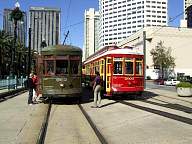 |
|
| Pictures 575, 576, and 577. | |
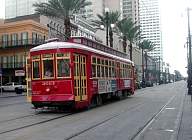 |
It is now May 8, 2009, and all Canal line service, on both branches, is being provided by refurbished Von Dullen 2000-series red cars. The top picture features car 2013 as Canal-Cemeteries run 5 outbound at the Canal & Royal intersection; the second picture shows car 2010 running as Canal-City Park run 31 at the same location; and in the third picture car 2001 is holding down Canal-City Park run 30, inbound at Canal and St. Charles. Note that the center sign on the Carrollton branch cars, which should display the route name Canal, sometimes shows City Park instead. RTA is not consistent in their use of the roll sign selections available. Car 2001 is just recently out of the shop, and is perhaps the most recent car to reenter service. — photos by the author |
 |
|
 |
|
| Picture 578. | |
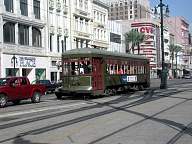 |
The green Perley Thomas cars are now once again restricted to the St. Charles line, and operate on Canal Street only the one block between Carondelet and St. Charles Streets, as we see car 940 doing the morning of May 8, 2009. However, for a time, all operating cars, including the Perley Thomas cars, were housed at Canal Station SIS, and operated from there, with Carrollton Station being used solely as a shop. So the green cars could still be seen on Canal Street between Canal Station and this point, going back and forth to their car barn. As of 2010, the St. Charles cars have again returned to their home at Carrollton Station. — photo by the author |
| Picture 579. | |
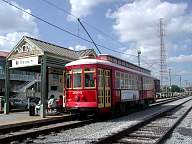 |
Here is Von Dullen car 2004, the second refurbished car, serving the Riverfront line at stop #3 Dumaine Street on May 8, 2009. The car is downbound, toward the French Market terminal at Esplanade Ave. Until the 457-463 series cars could be refurbished, the 2000-series cars, originally built for the Canal line, were used on Riverfront as well as on Canal. The Riverfront cars 457-463 began to return to service in early 2010. — photo by the author |
Streetcar expansion continued in New Orleans in 2012 and 2013. After a prolonged construction period, a new Loyola Line was opened January 28, 2013 on Loyola Avenue between Canal Street and the Union Passenger Terminal (UPT), the Amtrak and Greyhound terminal facility at the head of Howard Avenue.
This short line was operated from UPT down Loyola Avenue to Canal Street, then in on Canal to the pocket track at the foot of Canal. The cars displayed a “LOYOLA/UPT” route sign, and the destination sign displayed was “HARRAH'S”. On the weekends, operation was extended down the Riverfront trackage to the French Market terminal at Esplanade Avenue. The red 2000-series Von Dullen cars are used in this service. On opening day, these were cars 2002 and 2003, which operated the ceremonial first runs, and cars 2006, 2008, and 2016.
The line is unusual in New Orleans streetcar practice in one especially notable way. Instead of operating in the neutral ground of Loyola Avenue, tracks were laid in the inner traffic lanes, with stations in the neutral ground, similar to the arrangement of the N. Carrollton branch of the Canal Line.
The Loyola track connections at Canal Street (notice that the last block to Canal is actually named Elk Place) form half a grand union; i.e., tracks are arranged so that a car can turn into Loyola from either direction on Canal, and can turn from Loyola into Canal in either direction. The partial connections at Canal and Basin (across Canal from Elk Place), which had been installed about ten years earlier in anticipation of a future Desire or St. Claude line, were removed, although the connections at N. Rampart Street remained.
Click here to view a map of Canal Street trackage in 2013 after construction of the Loyola/UPT line.
During 2015 and 2016, a new streetcar line was constructed on N. Rampart Street, turning into St. Claude Avenue and ending in a double-track scissors crossover at Elysian Fields. The tracks were laid in the street, next to the neutral groundd, like the tracks on the Loyola/UPT line and those on the N. Carrollton branch line. A second half-grand-union was constructed on Canal at N. Rampart, removing the final remnant of the anticipated rail connection (never used) from the earlier construction at that intersection.
The line opened October 2, 2016, and was designated the Rampart–St. Claude streetcar line. It is operated as a through route with the Loyola/UPT line, which no longer goes to the foot of Canal Street or to the Riverfront terminal at Esplanade. Cars operate from UPT to Canal Street, one block on Canal to Rampart Street, then out N. Rampart and St. Claude to Elysian Fields, returning over the same route. Typical signs displayed include the route sign “LOYOLA/UPT” (although RTA literature refers to the line as Rampart-St. Claude), with destination sign "ELYSIAN FIELDS" when the car is operating toward that terminal.
The cemeteries terminal of the Canal line at City Park Avenue had been considered temporary when it was built and opened in 2004, for several reasons. Perhaps the most important was that passengers leaving the streetcars to transfer to one of the several bus routes near that point had to make their way through a busy intersection, with little protection. While there were traffic signals at Canal Street and City Park Avenue, there were only simple stop signs on Canal Blvd. at City Park Avenue.
After consideration of various suggested permanent terminals, it was decided to build one in the neutral ground of Canal Blvd., on the lake side of City Park Avenue. Beginning July 31, 2017, and completed on December 4, a new loop terminal was built there, adding a two-track loop with passenger shelters for the streetcars, and a similar loop for connecting bus routes, with a sheltered walkway between. The outbound track in the Canal Street neutral ground, and the inbound track in the innermost traffic lane, were extended around the corner on City Park Avenue, turning immediately into Canal Boulevard, and new traffic signals were installed on all parts of the complex intersection. The new terminal provides passengers with better access to transfer between the streetcars and connecting bus lines. Following a month of testing and training, the new terminal went into service January 7, 2018.
Acknowledgements and References
[1] Louis C. Hennick & E. Harper Charlton, The Streetcars of New Orleans,
Pelican, 1975.
[2] Louis C. Hennick, The Streetcars of New Orleans, “Appendix III,”
unpublished manuscript, 2005.
[3] Maps of New Orleans in the Tulane University library, including in
particular an 1895 map, a New Orleans Railway map of 1904, and a New Orleans
Railway and Light Co. (NOR&L) map of May 1907.
[4] Robertson Atlas of 1883, New Orleans Notarial Archives, plates 1 and 4.
[5] Various reports issued by NOR&L.
[6] The reports issued by J. E. Allison & Co. in 1917 and J. A. Beeler in 1922,
summarizing their studies of the street railway system.
[7] Bryson Vallas (City Engineer of New Orleans), "New Orleans Rejuvenates
Canal Street", The American City, May 1930, about the 1929 rebuilding
of Canal Street.
[8] Various official records of New Orleans Public Service Inc. (NOPSI),
which that company generously made available for my inspection in the late 1950s.
[9] Personal observations of the 1957 and 1997 rebuildings,
1950s rush hour operation, and 2005 operations.
My thanks to Otto Goessl for explaining to me the pre-1950 operations at Canal and City Park Ave., and to Morris Hill for his research into old court records and his contributions to understanding several of the nineteenth century pictures in Part 1 of this article.
Most of the pictures of the horsecar era are taken from stereoptican pictures, and the rest mostly from picture postcards. Many of the pictures of early electric streetcars are also from picture postcards. Photographs of recent events were donated by several contributors, as noted; their generosity is gratefully acknowledged. Publishers and photographers are credited where known. All cards and pictures are in the author's collection, except as noted.
Text, captions, photos by R. Hill, and photos by the author, Copyright © 1999, 2000, 2001, 2002, 2003, 2004, 2005, 2006, 2007, 2008, 2009, 2010, 2011, 2012, 2013, 2014, 2015, 2016, 2017, 2018 H. George Friedman, Jr. All rights reserved. Permission is hereby given for the QUOTATION of SHORT excerpts, as long as credit is given to H. George Friedman, Jr.
Computer Science Department, University of Illinois at Urbana-Champaign, Home Page